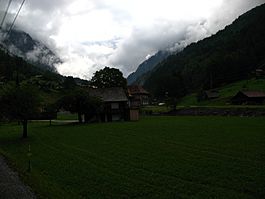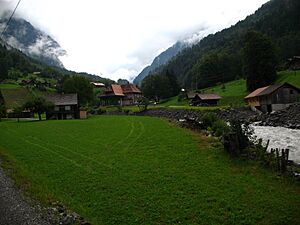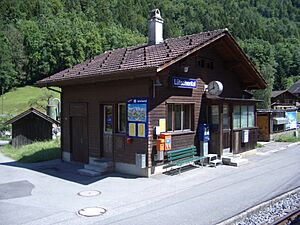Lütschental facts for kids
Quick facts for kids
Lütschental
|
||
|---|---|---|

Schwarze Lütschine river in Lütschental village
|
||
|
||
| Country | Switzerland | |
| Canton | Bern | |
| District | Interlaken-Oberhasli | |
| Area | ||
| • Total | 12.28 km2 (4.74 sq mi) | |
| Elevation | 714 m (2,343 ft) | |
| Population
(Dec 2020 )
|
||
| • Total | 214 | |
| • Density | 17.43/km2 (45.13/sq mi) | |
| Postal code |
3816
|
|
| Surrounded by | Grindelwald, Gündlischwand, Iseltwald, Lauterbrunnen | |
| Twin towns | Bettlach (Switzerland) | |
Lütschental is a small village and a municipality in the Interlaken-Oberhasli area of the canton of Bern in Switzerland. It's a quiet place nestled in a beautiful valley.
Contents
History of Lütschental
Lütschental was first mentioned in old records in 1238, called Liscinthal. Later, in 1275, it was known as Lyzental.
Early Times and the Monastery
During the Middle Ages, the Lütschine valley was part of a larger area called the Herrschaft of Unspunnen. This was like a small territory ruled by a lord. In the 1200s and 1300s, a place called Interlaken Monastery started to buy land and rights in the village. Eventually, they owned most of the land and had control over many people living there.
In 1349, the people of Lütschental joined other villages in the Bernese Oberland (a region in the canton of Bern) to rebel against the monastery. However, their rebellion was not successful.
The Reformation and Bern's Rule
In 1528, the city of Bern decided to change its religion to Protestantism, which was part of the Reformation. Bern then tried to make everyone in the Bernese Oberland follow this new faith. Lütschental, along with many other villages and the monastery itself, rebelled again. But once more, they were not successful.
After Bern took control, they closed the monastery and took all its lands. Lütschental then became part of Bern's bailiwick (an area managed by a special officer) called Interlaken.
Modern Times and Jobs
Towards the end of the 1800s, the number of people living in Lütschental started to decrease. Many residents moved to bigger cities in the Swiss Plateau or left Switzerland to find work.
In 1908, a power plant was built for the Jungfrau railway, which created some new jobs. However, this wasn't enough to stop the population from shrinking. Today, some people in Lütschental raise animals in the mountain pastures. There's also a small tourism industry. About half of the people who work in Lütschental travel to jobs in the nearby municipality of Grindelwald.
Geography of Lütschental
Lütschental covers an area of about 12.4 square kilometers (about 4.8 square miles).
Land Use
Here's how the land in Lütschental is used:
- About 22.6% is used for farming.
- Nearly half (47.6%) is covered by forests.
- A small part (1.9%) has buildings or roads.
- A tiny bit (0.6%) is rivers or lakes.
- About 27.6% is unproductive land, meaning it's not used for farming or building.
Most of the forested land is dense forest, and some areas have orchards or small groups of trees. The farming land includes pastures for animals. All the water in the municipality is flowing water, like rivers. The unproductive areas are mostly rocky or have plants that aren't useful for farming.
Mountains and Rivers
The highest mountain in Lütschental is Winteregg, which is 2,555 meters (8,383 feet) tall. Lütschental is located in a valley that stretches from Interlaken to Grindelwald. The name Lütschental actually means "valley of the Lütschine River", which flows right through it.
Lütschental is part of the church parish of Gsteig bei Interlaken, which is in the municipality of Gsteigwiler.
Administrative Changes
On December 31, 2009, the old district that Lütschental belonged to, called Amtsbezirk Interlaken, was closed down. The very next day, January 1, 2010, Lütschental became part of a new administrative area called Verwaltungskreis Interlaken-Oberhasli.
Coat of Arms
The blazon (a special description) of Lütschental's municipal coat of arms says: Or a Chamois statant Sable on a Rock Argent. This means it shows a black chamois (a type of goat-antelope) standing on a silver rock, all on a gold background.
Population of Lütschental
Lütschental has a population of 214 people. In 2010, about 7.2% of the people living there were foreign nationals (people from other countries). Over the ten years from 2000 to 2010, the population decreased by about 8.4%. This was partly because more people moved away than moved in, and also because there were more deaths than births.
Languages Spoken
Most people in Lütschental (about 96.4% in 2000) speak German as their main language. Albanian is the second most common language, and Dutch is the third.
Population Breakdown
In 2008, about 53% of the population were male and 47% were female. Most of the people were Swiss citizens.
In 2000, about 45.1% of the people living in Lütschental were born there. Another 37.2% were born in the same canton (Bern), while 9.1% were born elsewhere in Switzerland, and 5.9% were born outside of Switzerland.
In 2010, children and teenagers (0–19 years old) made up 21.2% of the population. Adults (20–64 years old) were 59.3%, and seniors (over 64 years old) were 19.5%.
Households
In 2000, there were 105 single people who had never been married. There were 121 married people, 17 widows or widowers, and 10 divorced people.
Also in 2000, there were 20 households with only one person and 11 households with five or more people. Most apartments (68.5%) were lived in all the time, while some (26.0%) were used only during certain seasons, and a few (5.5%) were empty.
The chart below shows how the population of Lütschental has changed over many years:

Transport in Lütschental
Lütschental railway station is a train station in the village. Trains from the Berner Oberland Bahn stop here every hour or even more often. These trains connect Lütschental to Interlaken Ost and Grindelwald.
Economy of Lütschental
In 2011, the unemployment rate in Lütschental was 1.92%, which means very few people were looking for jobs. In 2008, there were 74 people working in the municipality.
Main Job Sectors
Jobs are often grouped into three main sectors:
- Primary sector: This includes jobs that get raw materials from nature, like farming or forestry. In Lütschental, 38 people worked in this sector, mostly in agriculture. There were about 15 businesses in this area.
- Secondary sector: This involves making things, like in factories or construction. In Lütschental, 14 people worked in this sector, with one business.
- Tertiary sector: This includes jobs that provide services, like shops, hotels, or schools. In Lütschental, 22 people worked in this sector, with 6 businesses.
In 2008, there were 51 full-time equivalent jobs. This means if you add up all the hours worked by part-time and full-time employees, it equals 51 full-time jobs. Most of these jobs were in agriculture, hotels/restaurants, and education.
Commuting
In 2000, 16 workers traveled into Lütschental for their jobs, while 70 workers traveled out of the municipality to work elsewhere. This means more people leave Lütschental for work than come in. About 17.5% of the working population used public transportation to get to work, and 48.2% used a private car.
Religion in Lütschental
Based on the 2000 census:
- 14 people (5.5%) were Roman Catholic.
- 223 people (88.1%) belonged to the Swiss Reformed Church (a Protestant church).
- 8 people (3.16%) belonged to other Christian churches.
- 9 people (3.56%) were Islamic.
- 2 people (0.79%) said they didn't belong to any church, or were agnostic (not sure if God exists) or atheist (don't believe in God).
- 1 person (0.40%) did not answer the question about their religion.
Education in Lütschental
In Lütschental, about 99 people (39.1%) have finished non-mandatory upper secondary education. This is schooling after the basic required years. A smaller number, 3 people (1.2%), have completed higher education, like at a university or a specialized college (a Fachhochschule).
School System in Bern
The Canton of Bern has a school system that starts with one year of non-required Kindergarten. After that, students go to six years of Primary school. Then, they attend three years of required lower Secondary school. In lower Secondary, students are grouped based on their abilities. After lower Secondary, students can choose to continue their education or start an apprenticeship (learning a trade on the job).
Local Schools
During the 2010–11 school year, 23 students were attending classes in Lütschental. There were no kindergarten classes in the municipality that year. There was one primary class with 13 students. For lower secondary, there was one class with 10 students. One of these students was a resident from another country and spoke a different language than the classroom language.
In 2000, 15 students from Lütschental went to schools outside the municipality.
See also
 In Spanish: Lütschental para niños
In Spanish: Lütschental para niños






